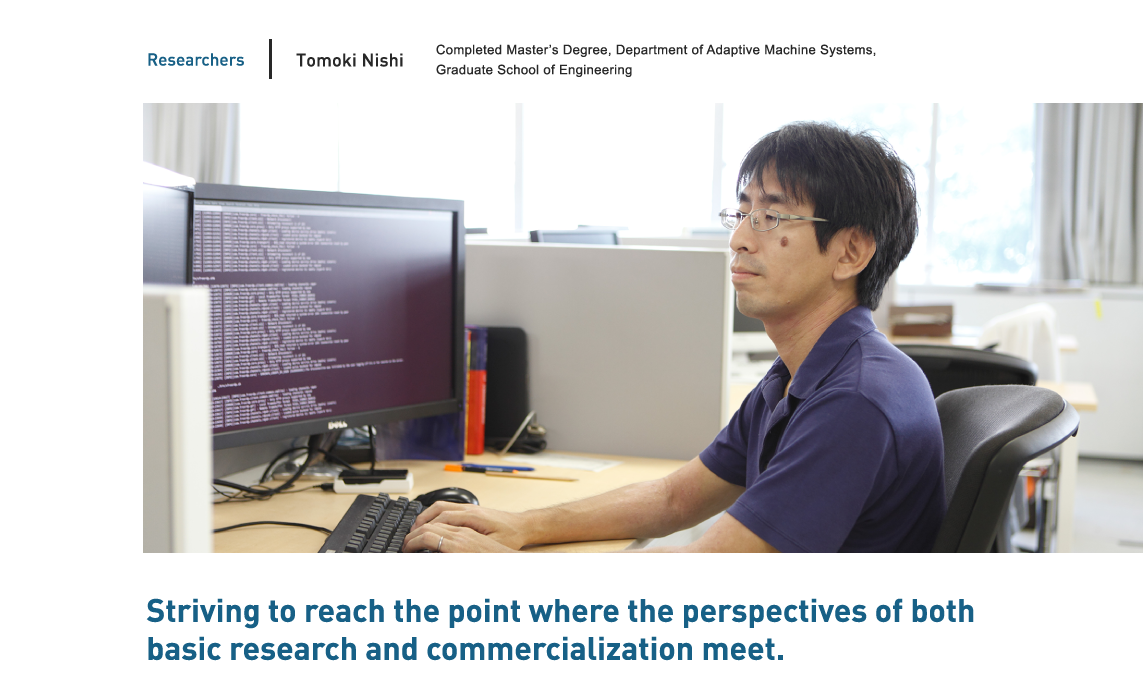


When I joined the company in 2007, Toyota Central R&D Labs., Inc. was also researching driving safety
systems, and I conducted related research with a relatively easy to picture end point. Recently, I am
striving to build things that go beyond themes with a predetermined end point. In social systems research,
for example, I was involved in the research and development of decision-making support systems that leverage
collective intelligence, while in research related to mobility, I participated in research on automated
driving at TRINA, the Toyota Motor Corporation research base in North America.
At TRINA, experiments involving automated driving vehicles making test drives on local highways amid
ordinary vehicle traffic are carried out daily as a matter of course. This allowed me to experience a
situation in which I had direct contact with research outcome on an everyday basis, ascertained subsequent
issues, and had to accept the opinions of society at large.
Automated driving actually has various levels. My own work was to develop functions to determine the
appropriate merging point and speed based on the behavior of nearby vehicles when merging onto a crowded
highway. I worked on developing methods to learn how to judge time and distance, which is easily done by
people, from data. Since coming back to Japan, I have continued to research machine learning algorithms
capable of making decisions in situations that change from moment to moment.


Robots have already found their way in various parts of our day-to-day lives. They have, for example, been
used in assembly plants for a long time. However, such robots can only perform predetermined tasks in a
specifically designed environment. In contrast, since I was in university, I have been researching robots
capable of learning autonomous behavior in complex environments such as playing soccer.
In the context of playing soccer, every game involves changes such as the participation of different players
or newly constructed turf for the pitch. The ability to learn is essential to performing a variety of tasks
in such an environment. I have wondered which segment of society will be the first to have commercialized
robots with superior learning ability. My own conclusion is that it will be automated driving. I joined
Toyota Central R&D Labs., Inc. because I believed I could leverage the research I did in university
here.
Upon joining, I first spent two years researching and developing algorithms to detect alcohol intake, which
was followed by two years of being involved in the research and development of methods to detect drowsy
driving. I have applied the research themes from my student days to find my own answers to the themes
derived from the needs of society or Group companies.

Venture businesses are common in the United States, and it is not uncommon to see university professors
launch a business based on technology they presented at a conference, and then commercialize it a year
later. My experience in that country, where outcomes are promptly turned into products and disseminated, has
strongly changed my awareness of how to give research outcomes back to society.
Looking at Toyota Central R&D Labs., Inc. through fresh eyes, some research is close to creating a product,
while other research is in a phase aimed at achieving an academic impact. This shows that the company offers
an environment that allows for any phase of research. I you want to do both, you have the opportunity to do
so, and if you want to pursue academic research, you can do that as well.
In current automated driving, minor differences in factors such as available information and scale or
tolerance for failure create situations that make it difficult to learn to make appropriate decisions, and
algorithms to learn decision-making at the commercial product level have yet to be established. I will
capitalize on the fact that Toyota Central R&D Labs., Inc. employs researchers from different fields and
provides an environment where we can benefit from opinions reflecting the perspectives of diverse
disciplines as I try to determine my next move.


In the morning, I come to work after taking my two-and-a-half year old to nursery school. With core work time starting at ten o’clock and everyone coming in at different times, short discussions naturally take place in the afternoon. The paper reading session at 5 P.M. is a meeting for researchers to introduce new papers or technology from any field to one another. It is an excellent opportunity to come in contact with perspectives from other fields.
*Details in the article are those at the time of the interview.